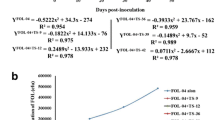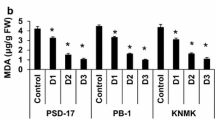Abstract
Maize is an agro-economically important crop and its global scale cultivation dates back to ancient times. It is vital to find organic solutions for the agricultural sustainability of maize. Trichoderma spp. is a cheap bio-control candidate having favorable effects on plant growth and enhances resistance to abiotic stresses. Herein, the effect of the endophytic fungus Trichoderma atroviride, our local isolate named ID20G (TaID20G), was evaluated in maize (Zea mays L.) seedlings under drought stress. The fungal strain was characterized based on the internal transcribed spacer (ITS) sequence of 5.8S rDNA. Relative water content, phenotypic characters of roots, antioxidant enzyme activity, hydrogen peroxide content, lipid peroxidation and chlorophyll fluorescence (Fv/Fm ratio) were recorded. Root colonization of TaID20G increased fresh and dry weight of maize roots under drought stress. Chlorophyll and carotenoid contents of seedlings were reduced by drought stress and membrane damage was high in uninoculated plants. Root colonization of TaID20G almost totally prevented increase in lipid peroxidation and reversed the changes caused by drought in pigment contents and photosystem efficiency. Antioxidant enzyme activity was induced and hydrogen peroxide (H2O2) content was less in response to drought stress in inoculated plants. Taken together, these data indicate that TaID20G inoculation could diminish the injurious effects of drought and might have a function in arranging resilience against stress by inducing antioxidant machinery. Low cost and effortless nature of Trichoderma-based formulas might be developed as crop protectors in drought-affected lands around the world, leading to an eco-friendly insight into the plant stress tolerance.





Similar content being viewed by others
References
Aebi HE (1983) Catalase. In: Bergmeyer HU (ed) Methods of enzymatic analysis, 3rd edn. Verlag Chemie, Weinheim, Florida, pp 273–286
Ahmad P, Hashem A, Abd-Allah EF et al (2015) Role of Trichoderma harzianum in mitigating NaCl stress in Indian mustard (Brassica juncea L.) through antioxidative defence system. Front Plant Sci doi:10.3389/fpls.2015.00868
Ahmed S, Nawata E, Hosokawa M et al (2002) Alterations in photosynthesis and some antioxidant enzymatic activities of mungbean subjected to waterlogging. Plant Sci 163:117–123
Alexandru M, Lazăr D, Ene M et al (2013) Influence of some Trichoderma species on photosynthesis intensity and pigments in tomatoes. Rom Biotech Lett 18:8499–8510
Arnon DI (1949) Copper enzymes in isolated chloroplasts. Polyphenoloxidase in Beta vulgaris. Plant Physiol 24:1–15
Asada K (1999) The water–water cycle in chloroplasts: scavenging of active oxygens and dissipation of excess photons. Annu Rev Plant Physiol Plant Mol Biol 50:601–639
Bae H, Sicher RC, Kim MS et al (2009) The beneficial endophyte Trichoderma hamatum isolate DIS 219b promotes growth and delays the onset of the drought response in Theobroma cacao. J Exp Bot 11:3279–3295
Bailey BA, Bae H, Strem MD et al (2006) Fungal and plant gene expression during the colonization of cacao seedlings by endophytic isolates of four Trichoderma species. Planta 224:1449–1464
Beauchamp C, Fridovich I (1971) Superoxide dismutase: improved assays and an assay applicable to acrylamide gels. Anal Biochem 44:276–287
Behera RK, Mishra PC, Choudhary NK (2002) High irradiance and water stress induced alterations in pigment composition and chloroplast activities of primary wheat leaves. J Plant Physiol 159:967–973
Bradford MM (1976) A rapid and sensitive method for the quantitation of microgram quantities protein utilizing the principle of protein-dye binding. Anal Biochem 72:248–254
Castillo FJ (1996) Antioxidative protection in the inducible CAM plant Sedum album L. following the imposition of severe water stress and recovery. Oecologia 107:469–477
Chepsergon J, Mwanburi L, Kassim MK (2014) Mechanism of drought tolerance in plants using Trichoderma spp. Int J Sci Res 3:1592–1595
Dhindsa RS, Matowe W (1981) Drought tolerance in two mosses: correlated with enzymatic defence against lipid peroxidation. J Exp Bot 32:79–91
Dixon D, Lapthorn A, Edwards R (2002) Plant glutathione transferases. Genome Biol 3.3:Rev 3004.1–Rev 3004.10
Doni F, Isahak A, Che Mohd Zain CR et al (2014) Physiological and growth response of rice plants (Oryza sativa L.) to Trichoderma spp. inoculants. AMB Express 4:45
Foyer CH, Halliwell B (1976) Presence of glutathione and glutathione reductase in chloroplast: a proposed role in ascorbic acid metabolism. Planta 133:21–25
Harman GE (2006) Overview of mechanisms and uses of Tricho-derma spp. Phytopathology 96:190–194
Harman GE, Petzoldt R, Comis A et al (2004) Interactions between Trichoderma harzianum strain T22 and maize inbred line Mo17 and effects of these interactions on diseases caused by Pythium ultimum and Colletotrichum graminicola. Phytopathololgy 94:147–153
Hashem A, Abd Allah EF, Alqarawi AA et al (2014) Alleviation of abiotic stress in Ochradenus baccatus (Del.) by Trichoderma hamatum (Bonord.) Bainier. J Plant Interact 9:857–868
Hassan MM, Daffalla HM, Modwi HI et al (2013) Effects of fungal strains on seeds germination of millet and Striga hermonthica. Uni J Agr Res 2:83–88
Heath RL, Packer L (1968) Photoperoxidation in isolated chloroplast. I. Kinetics and stochiometry of fatty acid peroxidation. Arch Biochem Biophys 125:189–198
Karaoglu SA, Ulker S (2006) Isolation, identification and seasonal distribution of soilborne fungi in tea growing areas of Iyidere-Ikizdere vicinity (Rize-Turkey). J Basic Microbiol 46:208–218
Liu ZJ, Guo YK, Bai JG (2010) Exogenous hydrogen peroxide changes antioxidant enzyme activity and protects ultrastructure in leaves of two cucumber ecotypes under osmotic stress. J Plant Growth Regul 29:171–183
Martínez-Medina A, Alguacil MDM, Pascual JA et al (2014) Phytohormone profiles induced by Trichoderma isolates correspond with their biocontrol and plant growth-promoting activity on melon plants. J Chem Ecol 40:804–815
Mastouri F, Bjorkman T, Harman GE (2010) Seed treatment with Trichoderma harzianum alleviates biotic, abiotic, and physiological stresses in germinating seeds and seedlings. Phytopathology 100:1213–1221
Mastouri F, Bjorkman T, Harman GE (2012) Trichoderma harzianum enhances antioxidant defense of tomato seedlings and resistance to water deficit. Mol Plant Microbe Interact 25:1264–1271
Mittler R (2002) Oxidative stress, antioxidants and stress tolerance. Trends Plant Sci 7:405–410
Nakano Y, Asada K (1981) Hydrogen peroxide is scavenged by ascorbate-specific peroxidase in spinach chloroplasts. Plant Cell Physiol 22:867–880
Nar H, Saglam A, Terzi R et al (2009) Leaf rolling and photosystem II efficiency in Ctenanthe setosa exposed to drought stress. Photosynthetica 47:429–436
Rawat L, Singh Y, Shukla N et al (2013) Salinity tolerant Trichoderma harzianum reinforces NaCl tolerance and reduces population dynamics of Fusarium oxysporum f.sp. ciceri in chickpea (Cicer arietinum L.) under salt stress conditions. Arch Phytopathol Plant Prot 146:1442–1467
Resende MP, Jakoby ICMC, dos Santos LCR et al (2014) Phosphate solubilization and phytohormone production by endophytic and rhizosphere Trichoderma isolates of guanandi (Calophyllum Brasiliense Cambess). Afr J Microbiol Res 8:2616–2623
Saba HDV, Manisha M, Prashant KS et al (2012) Trichoderma—a promising plant growth stimulator and Biocontrol agent. Mycosphere 3:524–531. doi:10.5943/mycosphere/3/4/14
Shukla N, Awasthi RP, Rawat L et al (2012) Biochemical and physiological responses of rice (Oryza sativa L.) as influenced by Trichoderma harzianum under drought stress. Plant Physiol Biochem 54:78–88
Shukla N, Awasthi RP, Rawat L (2015) Seed biopriming with drought tolerant isolates of Trichoderma harzianum promote growth and drought tolerance in Triticum aestivum. Ann Appl Biol 166:171–182
Smirnoff N (1998) Plant resistance to environmental stress. Curr Opin Biotech 9:214–219
Velikova V, Yordanov I, Edreva A (2000) Oxidative stress and some antioxidant systems in acid rain-treated bean plants, protective role of exogenous polyamines. Plant Sci 151:59–66
Author information
Authors and Affiliations
Corresponding author
Ethics declarations
Conflict of interest
The authors whose names are listed above state that they have no conflict of interest in the subject matter or materials discussed in this manuscript.
Additional information
Communicated by MH Walter.
N. S. Guler and N. Pehlivan are co-first authors.
Rights and permissions
About this article
Cite this article
Guler, N.S., Pehlivan, N., Karaoglu, S.A. et al. Trichoderma atroviride ID20G inoculation ameliorates drought stress-induced damages by improving antioxidant defence in maize seedlings. Acta Physiol Plant 38, 132 (2016). https://doi.org/10.1007/s11738-016-2153-3
Received:
Revised:
Accepted:
Published:
DOI: https://doi.org/10.1007/s11738-016-2153-3




